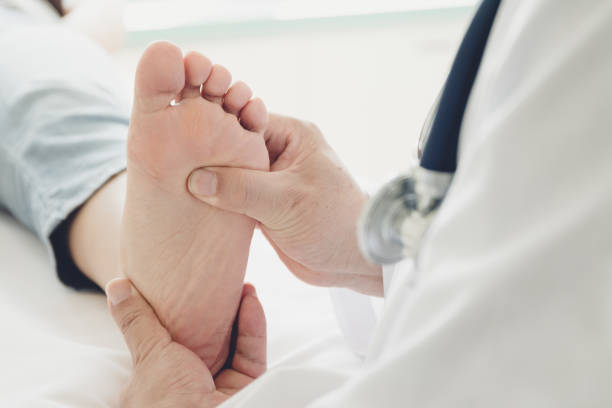Heel pain can rob you of your ability to exercise and live life. Fortunately, you can often find relief by avoiding aggravating activities and using over-the-counter medications.
If at-home treatment doesn’t relieve your heel pain, you should see a podiatrist for help. Podiatrist Northside can identify the cause of your heel pain and help you find solutions that work.

Plantar Fasciitis
In this condition, the plantar fascia (the band of tendon-like tissue that extends across the bottom surface of the foot to the toes) is strained beyond its capacity and irritated by repetitive stress. The result is that soft tissue fibers will tear or stretch at points of irritation, causing inflammation and sometimes a heel spur.
The classic symptom of plantar fasciitis is pain at the beginning of activity that lessens or resolves as the foot becomes warmed up. The pain is usually limited to the inferior medial calcaneal tubercle, which serves as the point of origin for the anatomic central band of the plantar fascia and the flexor hallucis, flexor digitorum brevis, and flexor digiti minimi muscles.
Heel pain from plantar fasciitis typically results from excessive walking, running or jumping; wearing poorly constructed footwear (especially flimsy flip-flops); being overweight; or aging, which may cause the plantar fascia to lose its elasticity.
Podiatrist Northside will check the bottom of your foot for areas of tenderness and may order x-rays or an MRI to make sure another problem, such as a stress fracture, is not causing your pain. Your doctor may also suggest home treatments, including resting your foot and applying ice to reduce swelling. If these don’t help, your doctor may prescribe oral or injectable anti-inflammatory medication, a splint to wear at night that keeps the foot upright and flexed, or strapping the foot with elastic supports.
Achilles Tendinitis
Achilles tendinitis is the most common cause of heel pain in people who are active. It occurs when the Achilles tendon (which connects your calf muscles to your heel bone) becomes irritated or damaged. It usually affects people who exercise frequently, especially those who participate in running and jumping sports. It can also occur in people who wear shoes that don’t fit well or work out on uneven surfaces, as well as those who suddenly increase the intensity or duration of their exercise programs.
Symptoms include pain and stiffness in the back of your leg as you walk or run. The pain is usually worse after you exercise and can last for several weeks or months. Over-the-counter pain relievers like ibuprofen can help reduce the pain and inflammation. If the condition is severe or doesn’t respond to treatment, your doctor may recommend injections of a steroid to decrease inflammation and improve healing.
Your doctor will ask you about your symptoms and medical history, then examine the area of your heel and calf. They’ll press on the area to locate areas of tenderness and swelling. The doctor can also perform a test called the Thompson test by squeezing the calf muscle. If the tendon doesn’t move downward, it could be a sign of a ruptured Achilles tendon. Your doctor might order an ultrasound or magnetic resonance imaging (MRI) to visualize the tendon and determine whether there are microtears in the Achilles tendon.
Bursitis
Bursae are fluid-filled sacs that your body has in most major joints. They help cushion the area, ease friction, and lubricate movement between bones and tendons or muscles. When irritated, they swell up and can be painful to touch. Heel bursitis occurs when the retrocalcaneal bursa at the back of the heel becomes swollen and painful. Bursitis can affect other areas of the body as well, such as the shoulder, hip, elbow, and knee joints.
Heel bursitis pain usually feels like a sharp pain in the back of your heel that is worse when you stand, walk or run. You may also notice that the area is red and puffy.
This condition is caused by wearing shoes that don’t fit correctly and by increasing your activity level suddenly, especially if the activity involves repeated rubbing on the area. Certain medications and medical conditions — such as rheumatoid arthritis and gout — can increase your risk of getting heel bursitis.
Rest and icing the area can help reduce swelling, pain and inflammation. Your doctor can recommend an over-the-counter pain reliever, such as acetaminophen (Tylenol) or nonsteroidal anti-inflammatory drugs (NSAIDs) to reduce pain and swelling. Physical therapy can help strengthen the calf muscle and Achilles tendon to take pressure off the bursae. Your doctor might also recommend steroid injections to lower pain and swelling. In rare cases, surgery might be needed to remove the inflamed bursa.
Stress Fractures
Stress fractures can occur in the calcaneus, or heel bone. These types of fractures usually happen because of repeated impact on the foot. Often people experience pain under the bottom of their heel with this injury. The symptoms can mimic plantar fasciitis and Achilles tendinitis, so it can be difficult to diagnose the problem. These fractures may also occur in people with very weak bones due to a separate health condition (such as osteoporosis).
Unlike most other heel problems, these types of fractures do not come on gradually. They often develop in people who suddenly increase the intensity or frequency of their exercise, training, or work activities, such as a weekend runner who decides to start training for a marathon or a child who begins playing one sport year round without a break between seasons. People with tight calf muscles are also more prone to developing stress fractures in the bottom of their heel.
Stress fractures can be very serious if not treated right away. People with these injuries should not resume their normal physical activities until their provider says it is safe. The best way to prevent these types of injuries is to always warm up and cool down before physical activity, to never “play through pain,” and to wear proper footwear for all sports and exercises.